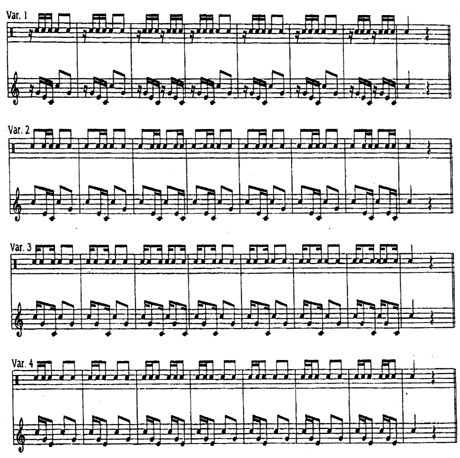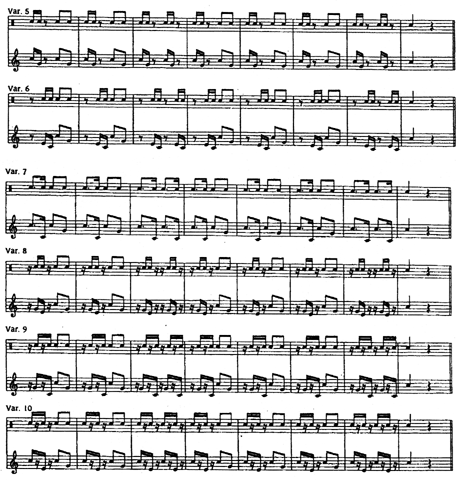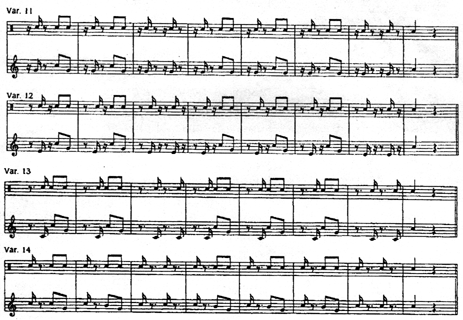Music is our universal language and building a vocabulary to communicate our ideas is an essential step for all musicians. We’d all agree a solid rhythmic foundation is necessary for good sight reading and consistency in any musical performance. For the student, learning to recognize and respond to patterns gets them beyond the note-by-note stage of reading music. At the same time pattern recognition helps to improve technical facility since the player now concentrates on a unit larger than a single note value.
This article aims to assist band directors & educators in helping the percussionist by using rhythmic building blocks as a means of improving music reading skills. These building blocks are one-beat rhythm patterns. Let’s focus on the sixteenth note subdivision, a common unit in much of the percussion repertoire. All examples are written for non-pitched instruments and keyboard percussion.
A Simple Check Pattern
Use the “natural sticking” method (RLRL) to learn the following Check Pattern. Go slow at first! Tap your foot, and feel solid downbeats.

Establishing a consistent method for sticking rhythm patterns is equivalent to learning fingerings for the brass and woodwind player, or defining bowing for string instruments. We now have a standard approach. Something uniform. A foundation to build on! As the student gains experience the sticking combinations will vary to improve control or lend expressive qualities to the music. For now though, let’s keep it simple.
Although some of the sticking combinations may seem a bit awkward for the mallet percussionist the discipline of standardized sticking is important. Often mallet players are drawn from other instruments like piano, double reed, guitar, etc. Generally these students are more talented melodically but in need of developing hand coordination skills. They tend to choose sticking patterns based on ease and comfort. Although convenient, it may not be the best way of achieving a good sound, or improving technically. The discipline of consistent sticking will also help to develop better rhythmic skills (tempo control and accuracy). Again, variety will come later.
14 Duple Variations
These one-beat patterns are grouped according to 3 note variations (1-4), two note variations (5-10), and one note variations (11-14). With the natural sticking method every lst and 3rd sixteenth note is played on the (R)ight hand, and every 2nd and 4th sixteenth note is played on the (L)eft hand. For eighth notes, the downbeat is always a (R)ight and the upbeat a (L)eft. Make certain the student understands this concept and applies it to all the following variations. Go slow at first! Tap your foot and feel solid downbeats. With consistent practice all syncopation should feel natural. And remember, always look at the music! This helps the recognition skill.
Three Note Patterns
With patterns 1-4 work to achieve the natural flow, or connected stick motion from note to note.

Two Note Patterns
Still strive for a relaxed stick motion, but concentrate on accurate note length and spacing of the rests. Make certain the downbeat tempo remains consistent especially with variations 8 and 9.

One Note Patterns
In many ways, these variations are the most challenging. The goal is to accurately place the note inside the beat while developing a feel for the space which is rested. “Silence is golden.”

The process of teaching these one-beat rhythm variations will take some time. Be patient and strive for consistency. The payoff is incredibly beneficial!
Mastering these basics will help improve sight reading skills, accuracy, and consistency of sound. While doing so the student is expanding his/her vocabulary for soloing.
Take-aways
Remember, the objectives are:
- Read by recognition (recognize and respond to patterns).
- Implement a consistent method of sticking for one-beat rhythm patterns.
- Develop accuracy and control of silence and note length.
- Emphasize tempo control and placement of the downbeat.
The one common denominator for all performers is rhythm. Try this system with your percussionists first. If you find some success consider adapting these concepts to the other areas of your music program. Good luck!

Hello and thanks!
I am teaching a course on sight reading at Muzik school (http://www.muzik.co.il/), which is aimed mainley for guitarists. I will try to apply ideas from your page into the teaching. It seems very helpful for me, and I will try to give feedback after prctice.
All the best,
Yiftah
Thom, I’m a bit confused about your definition of “Natural Sticking”. On page 7 of your book you define the eighth note in duple meter as either two rights or two lefts. Your explanation on page 17 you define the eighth note as a right/left. That seems inconsistent with the beginning explanation. Please advise.
After writing a book for myself with this same fundimental repitoire I saw this. Thom Hannum has presented the material beautfuly. Thank you Thom!